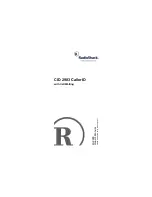
Page
3
of
3
36931-751-16
Safety Instructions
29.10.2013
Dr. Klausgrete
Drawing No.
Designation
Revision
00
Safety Instructions
These safety instructions apply to the installation, operation, maintenance and repair of the equipment
1)
Install the equipment in compliance with applicable laws, rules and regulations, ordinances and standards. In
particular, be sure to conform to the European Standards EN 60079-14 (Electrical apparatus for use in potentially
explosive gas atmospheres).
2)
Be sure to follow the installation, operating, maintenance and servicing instructions given in the manuals supplied.
3)
The cover screws must be
tighten to a torque of 2.5 … 3.0Nm (
PR6xxx/68S) and
2.0 … 2.5Nm (
PR6130/
64Sx and PR6130/65), respectively.
4)
The external connecting cables must be installed in a protective tube and secured to prevent damage and stress
caused by strain. The cable glands must be secured to prevent them from working loose. The applied cable
glands shall be suitable for the application of the junction box.
5)
The gasket shall not be lost or damaged.
6)
For corner load compensation wire wounded resistors with a maximum resistance of 5.6ohms
(P
70
= 0.6W
, 1%,
size 0207; type MBB0207 or equivalent) shall be used. Remove the wire bridge in the corresponding line to the
load cell and solder in the compensating resistor.
7)
Prior to opening the equipment, disconnect the power supply or make sure that there is no potentially explosive
atmosphere or any other explosion hazard in the surrounding area! Never connect or disconnect cables while the
power is on in a hazardous area! If the equipment does not operate properly, unplug it immediately from line
power (mains supply)!
8)
A transient protection device shall be set at a level not exceeding 140 % of the peak rated voltage value of 85V.
9)
All metal parts (housing, load cells) must be electrically connected to the terminal for the equipotential bonding
conductor (PA). The equipment operator is obligated to connect an earth cable with a gauge of at least 4 mm²
(cross section) and with a cable lug to the PA terminal located on the side of the housing. This earth cable must
be installed in such a way that it is protected against working loose and that it prevent twisting of the earth
connection. The low resistance of this connection to the PA busbar must be checked when the system is installed
at the intended place of use. For intrinsically safe circuits: The shielding of the connecting cables may only be
used for grounding when no impermissible difference in voltage is generated and, if necessary, the shielding is
able to conduct the equipotential current.
10) For use in zone 0 or in zone 20 the load cells and the output circuit of the evaluation unit to the load cells must be
intrinsically safe in type of protection Ex ia. For use in zone 1 or in zone 21 the load cells and the output circuit of
the evaluation unit to the load cells must be intrinsically safe in type of protection Ex ia or Ex ib. Load cells in type
of protection Ex tb are suitable to be used in zone 21 and 22. For gas and dust group, temperature code and
maximum ratings see DEKRA certificate.
11) For use in zone 2, 21 and 22 the load cells and the output circuit of the evaluation unit to the load cells do not
need to be intrinsically safe but must be suitable (certified) for use in these zones. For gas and dust group,
temperature code and maximum ratings see DEKRA certificate.
12) Keep chemicals and other agents, which can corrode the housing seals and cable sheaths, away from the
equipment. These agents include oil, grease, benzene, acetone and ozone. If you are not sure about the safety of
a certain substance, please contact the manufacturer.
13) Use equipment only in the temperature ranges indicated. Avoid exposing the equipment to heat.
14) The terminal blocks are suitable for wire gauges 0.2qmm. 1.5qmm (AWG 24 .. AWG 16). Secure the wires by
tighten to a torque of
0.5Nm. No torque must be applied to the plug-in connectors type LSF-SMT 5.08.
15) The equipment operator is responsible for any non-Sartorius cables used.
16) Check the EX approval marking (particularly the group for gases and temperature class) on all equipment in the
hazardous area before operation to ensure that this equipment is permitted to be operated in this area.
17) At reasonable intervals, have your equipment installation checked for proper functioning and safety by a trained
and certified technician.
18) If your equipment needs to be repaired, use only genuine replacement parts supplied by the manufacturer!
19) Any tampering with the equipment by anyone, other than repair work done by authorized Sartorius service
technicians, will result in the loss of EX conformity and in the forfeiture of all claims under the manufacturer's
warranty. Only authorized specialists may open the equipment.
20) Modifications, including those to be carried out by Sartorius employees, may be permitted only after the express
written authorization has been obtained from Sartorius.
21) For application in environments with combustible dust, electrostatic charging of the plastic label shall be avoided.































